
- Santiago Qispe, twenty-nine, hollows out a hole for dynamite in Pairaviri, the largest mine in Potosí, Bolivia. Qispe is the leader of a group of fi ve, mining silver and zinc. He went to work when he was twelve.
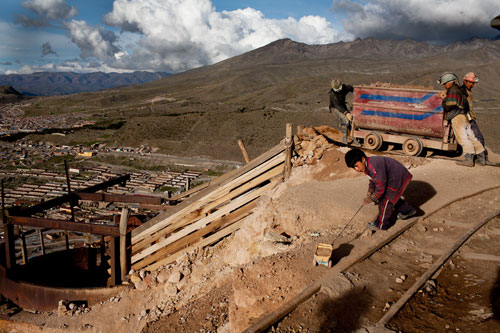
- At Caracoles Mine, men unload minerals into vats, which will later be hauled into town for processing. Mining is typically a generational occupation in Potosí. Many children start to help their family in the mine at a very young age, some as young as eight years old.
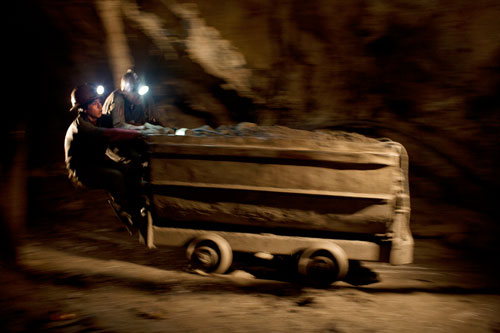
- German Flores (left), seventeen, and Emiliano Mamani, twenty-four, ride a cart full of minerals to the exit of Candelaria Mine. Flores has been working in the mine since he was twelve. Although underage labor is illegal in Bolivia, it is not enforced.
A day’s travel from the capital of La Paz lies the state of Potosí, a stretch of high altitude plains covered in scrub, plots of quinoa and potatoes, and homes made of mud brick. The houses are small and often lack windows, as darkness is preferable to the cold gusts of wind that gnash across the plains. Sometimes, if you venture across this landscape, known as the altiplano, a stick figure of a human can be seen at a distance, tending fields or herding animals. Even more infrequently several homes appear together—a town, where an indigenous man will be selling soda bottles of gasoline near the road, and his wife or daughter sells cola and bread and matches and telephone calls. To use the outhouse, she’ll charge half a boliviano, which also buys a length of toilet paper she cuts and folds between customers. Another such town might appear two hours later.
In the middle of this expanse sits the city of Potosí. Once one of the largest industrial complexes in the world, it now looks like many other Baroque castoffs, a collage of low, narrow doorways and ornate churches with warped fl oorboards. But this place is different, because here that past is breathing down your neck: above the city looms the mountain also called Potosí—the place that gave birth and a name to everything around it.
It put Bolivia on the map, and it’s why the state, the city—why any of Bolivia as we know it, and, arguably, much of South America—exists. This once held the biggest single deposit of silver in the world, as well as an enormous amount of tin, and Potosí also played a vital role in the Industrial Revolution. Yet the indigenous people who live here, many miners and descendents of those the Spanish enslaved, haven’t benefitted from Potosí’s enormous wealth. This is the place photographer Tim Hussin set out to document, and his pictures capture, with remarkable clarity and insight, the people whose lives are forged by this place.
Hussin, twenty-five, originally learned of Potosí via another, more recently popular trove of natural wealth: the nearby Salar de Uyuni, the world’s largest salt flat, with its unparalleled deposits of lithium for electric car batteries and laptops. Reading about the debate over who will harness and benefi t from these resources, Hussin came across references to Potosí—which indigenous Bolivians use as an example of just how thoroughly they’ve been exploited when it comes to natural resources. Eventually, he made his way there, while working as an intern for National Geographic magazine.
Potosí mountain is as neat as a child’s drawing— smooth slopes terminating in a pointed summit, pressed against a flat blue sky. Like everything at altitude, the colors change drastically, depending on the angle of the sun; the opaque blue of the sky becomes more or less saturated throughout the day, and the hill moves from bone to blazing rust, and back. For centuries, the miners have made their homes at its skirts, and a tapestry of their brick, cement, and corrugated metal shanties ties Potosí the city, to Potosí the mountain, to Potosí the broad, empty plain. Most of these miners spend their days underground, in hot, narrow, often wet tunnels, extracting ore with a combination of knowledge passed down between generations, a lot of guesswork, and dynamite. And though the environment can be overwhelming, for Hussin, who spent nearly three months photographing the lives of Potosí’s miners, it wasn’t the way the mine looked that first struck him, but the smells. “Muddy, strange, mineral smells,” he recalls, “the smell of gases and chemicals seeping from the earth.”
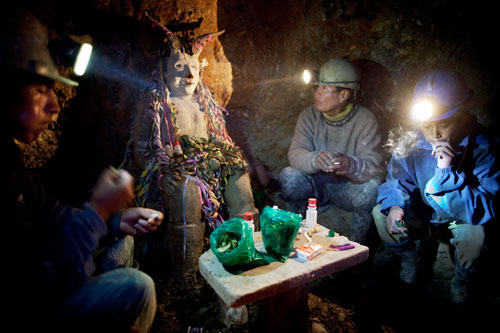
- Miners hold many traditions carried down from Spanish influence. One of the most important is paying respects to El Tío, the mountain devil introduced by the Spanish in the sixteenth century. They told workers that they had to work hard and make offerings to El Tío to stay safe underground. The belief remains strong today and there is a shrine of El Tío in every mine. Miners Aurturo Seco (left), Alejandro Seco (center), and Milton Seco (right) regularly make offerings of tobacco, coca leaves, and alcohol to El Tío.
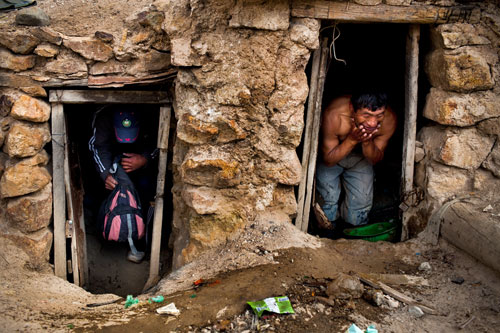
- At Candelaria Mine, men clean up after a day’s work underground. Every miner has a hut outside the mine where they stow belongings.
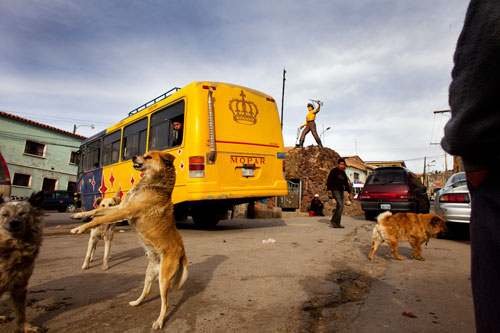
- The Miners’ Plaza was created in the 1950s to honor the men who had died during uprisings against private companies that were exploiting the workers. The government nationalized the mines and eventually turned them over to indigenous-run cooperatives.
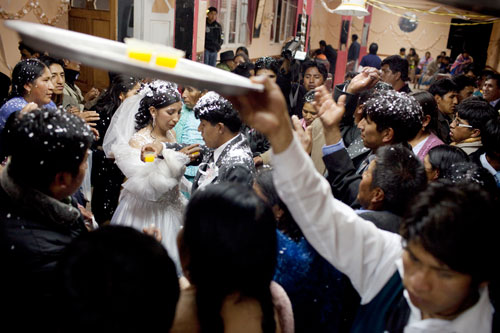
- Weddings last for three days with a different celebration on each day. Vilma Flores and Reynaldo Ramos, twenty-one, toast on the fi rst day of their wedding. Ramos is a miner at Mankiri Mine.
Today, the mountain has been so thoroughly ravaged that it threatens to collapse. There’s talk in Bolivia of filling it in to preserve its iconic form, the way a museum might stuff a bear. And why not. Everything here is a relic or a remnant.
I have visited Potosí a handful of times, and it always feels like looking into a series of moments that have been repeating themselves, with slight alterations, for centuries—beginning with that journey through the lunar altiplano. Then, in the city: always a religious procession at night, a dozen or so people huddled around a drawing or a statue of an icon, illuminated by candles as they move from one church to another, from home to cemetery, or to a shrine. This movement echoes the mine, and the way its long, dense darkness is broken occasionally by a rickety cart carrying mineral out, or miners in—ghosts made of muffl ed sound and the dull light of a headlamp, that evaporate away in a few seconds. Entering such spaces, it’s hard to ignore the sensation of inhabiting old rituals—from the miners, toiling in the entrails of the mountain, to the outsiders who come to collect something from them, be it a silver ingot or a story to tell.
Hussin, after an initial bout of claustrophobia, found himself lulled by the quiet and stillness underground, and comforted by the camaraderie of the men who work there. In fact, it’s that sense of seeking out community in the midst of apparent isolation that seems to draw Hussin through his work, from this series of photos of Potosí, to his most recent project—a cross-country bike trip with his brother, called America reCycled, that seeks to document sustainable communities and folk movements in the United States.
“What impressed me is that these guys are really proud to be miners. There’s a big sense of accomplishment and pride,” says Hussin. “And their work groups are their community. That group is a family, or a second family. Some joke that they enjoy being in the mine with the other men more than being with their families.”
As Hussin’s photographs attest, the world of the mine is full of negotiations, and they mark the miners who make them. One photo, for example, shows a single man with his clothing and skin the same color as the dank mineshaft, as if this, not the world above, were his natural environment. Another shot shows three miners sitting with a horned, human-looking statue draped in paper streamers. The fi gure is El Tío, the god of the mine, who can be both cruel and generous, damning the miners to accidents in the tunnels, but also bringing them riches there.
The miners recognize El Tío constantly: invoking his name, bringing him gifts of coca and alcohol, and staging celebrations in his honor, culminating with the yearly Carnival, when the miners decorate their tunnels, and make lavish offerings over many days. Then they proceed into town, dancing, playing music, and drinking; the sort of engulfi ng, collective drunkenness that is meant to seal pacts, to inhabit the fate you and yours have been dealt. And why should these miners believe things would be any different? Five hundred years of paying tribute—to foreign interests, to Potosí, to El Tío, and to the earth itself— has done little to convince them otherwise.
So they return to the mine once more, hoping that these sacrifi ces will get them through another year, protect them against all too common disfi gurement and death, provide for their families, and maybe even deliver a rich vein into their stained hands. All over Bolivia, and perhaps nowhere more so than Potosí—state, city, mountain—people have learned that to gain anything, they must fi rst be doused in history, celebration, and often blood.
Annie Murphy reported on the Chilean miner crisis for NPR and contributed the essay “Father Copper,” about Chilean copper mining, to the Fall 2010 issue.
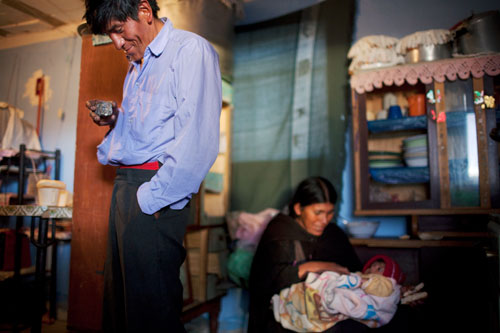
- Despite the continuing exploitation of Potosí’s miners, it is still possible for individuals to find a high quality vein of mineral and become rich. This is the hope for Basilio Julian, who found a pure piece of tin in Candelaria Mine and brought it home to examine closer.
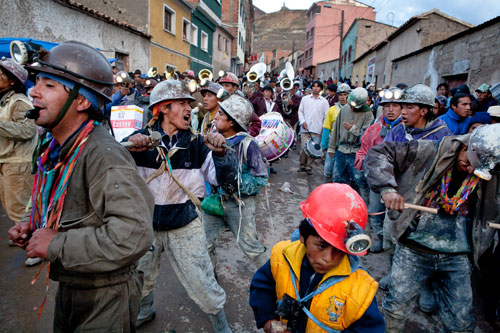
- Miners march down from Cerro Rico into the city during the annual Miners’ Carnival celebrating their history and culture. In contrast to many mining communities, the miners of Potosí take great pride in their work. During this festival, they bring sacred statues down from the mines to Catholic churches in town to be recharged with God’s energy.















